
Carl Paul Jennewein was a German-born American sculptor.

Alexander Stirling Calder was an American sculptor and teacher. He was the son of sculptor Alexander Milne Calder and the father of sculptor Alexander (Sandy) Calder. His best-known works are George Washington as President on the Washington Square Arch in New York City, the Swann Memorial Fountain in Philadelphia, and the Leif Eriksson Memorial in Reykjavík, Iceland.

Charles Allan Grafly, Jr. was an American sculptor, and teacher. Instructor of Sculpture at the Pennsylvania Academy of the Fine Arts for 37 years, his students included Paul Manship, Albin Polasek, and Walker Hancock.
Benjamin Franklin Parkway, commonly abbreviated to Ben Franklin Parkway and colloquially called the Parkway, is a boulevard that runs through the cultural heart of Philadelphia. Named for Benjamin Franklin, a Founding Father, the mile-long Parkway cuts diagonally across the grid plan pattern of Center City's northwest quadrant. It starts at Philadelphia City Hall, curves around Logan Circle, and ends before the Philadelphia Museum of Art.

Uriah Galusha Pennypacker was a Union general during the American Civil War. He may be the youngest person to hold the rank of brigadier general in the US Army; at the age of 20, he remains the only general too young to vote for the president who appointed him.
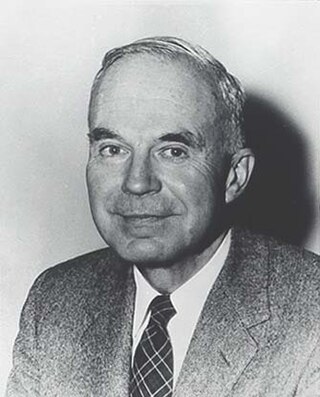
Walker Kirtland Hancock was an American sculptor and teacher. He created notable monumental sculptures, including the Pennsylvania Railroad World War II Memorial (1950–52) at 30th Street Station in Philadelphia, and the World War I Soldiers' Memorial (1936–38) in St. Louis, Missouri. He made major additions to the National Cathedral in Washington, D.C., including Christ in Majesty (1972), the bas relief over the High Altar. Works by him are presently housed at the U.S. Military Academy at West Point, the Library of Congress, the U.S. Supreme Court, and the United States Capitol.

Joseph Alexis Bailly was an American sculptor who spent most of his career in Philadelphia, Pennsylvania. He taught briefly at the Pennsylvania Academy of the Fine Arts, which has a collection of his sculpture. His most famous work is the statue of George Washington in front of Independence Hall.
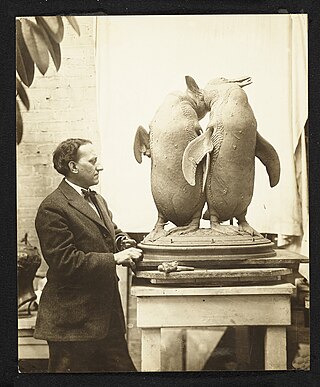
Albert Laessle was an American sculptor and educator. He taught at the Pennsylvania Academy of the Fine Arts for more than twenty years and is best remembered as an animalier. He won the 1918 Widener Gold Medal.
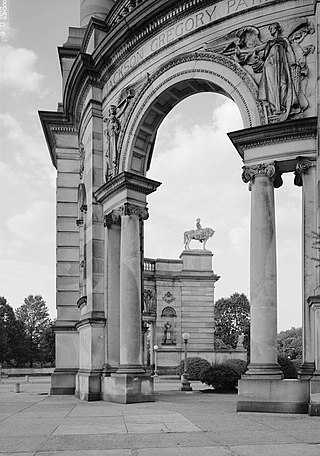
Smith Memorial Arch is an American Civil War monument at South Concourse and Lansdowne Drive in Philadelphia, Pennsylvania. Built on the former grounds of the 1876 Centennial Exposition, it serves as a gateway to West Fairmount Park. The Memorial consists of two colossal columns supported by curving, neo-Baroque arches, and adorned with 13 individual portrait sculptures ; two eagles standing on globes; and architectural reliefs of 8 allegorical figures.

The George Gordon Meade Memorial, also known as the Meade Memorial or Major General George Gordon Meade, is a public artwork in Washington, D.C. honoring George Meade, a career military officer from Pennsylvania who is best known for defeating General Robert E. Lee at the Battle of Gettysburg. The monument is sited on the 300 block of Pennsylvania Avenue NW in front of the E. Barrett Prettyman United States Courthouse. It was originally located at Union Square, but was removed and placed in storage for fourteen years before being installed at its current location. The statue was sculpted by Charles Grafly, an educator and founder of the National Sculpture Society, and was a gift from the state of Pennsylvania. Prominent attendees at the dedication ceremony in 1927 included President Calvin Coolidge, Governor John Stuchell Fisher, Secretary of the Treasury Andrew W. Mellon, and Senator Simeon D. Fess.

A statue of Abraham Lincoln by American artist Gaetano Cecere is installed along Lincoln Memorial Drive in Milwaukee, Wisconsin, United States. The 10'6" bronze sculpture depicts a young beardless Abraham Lincoln. The former president stands looking down with both hands at his sides.

Jakob Otto Schweizer was a Swiss-American sculptor noted for his work on war memorials.

John J. Boyle was an American sculptor active in Philadelphia in the last decades of the 19th century, known for his large-scale figurative bronzes in public settings, and, particularly, his portraiture of Native Americans.

The James A. Garfield Monument is a monument honoring the 20th President of the United States in Philadelphia, Pennsylvania, United States. Sculptor Augustus Saint-Gaudens and architect Stanford White collaborated on the memorial, which was completed in 1896. It is located in Fairmount Park, along Kelly Drive, near the Girard Avenue Bridge.
Lawrence Joseph Nowlan Jr. was an American sculptor and figurative artist known for his statues of notable individuals, including Harry Kalas and Jackie Gleason. Nowlan also designed memorials, including the firefighter sculptures at the Wildland Firefighters National Monument in Boise, Idaho, which was his first commission as a sculptor, and the war memorial in Windsor, Vermont. Additionally, Nowlan created the statuette awarded by several major ceremonies, including the ESPN ESPY Award and the My VH1 Music Awards. He was working on an 8-foot, 800 pound statue of Philadelphia boxer, Joe Frazier, at the time of his death in 2013.

All Wars Memorial to Colored Soldiers and Sailors is a war memorial in Philadelphia, Pennsylvania that honors the state's African American servicemen who fought in American conflicts from the American Revolutionary War to World War I. Commissioned by the Commonwealth of Pennsylvania in 1927, it was created by sculptor J. Otto Schweizer and dedicated July 7, 1934. In 1994 it was relocated from a remote site in West Fairmount Park to its present prominent site in Logan Square, along the Benjamin Franklin Parkway.
Edward Washburn Whitaker (1841–1922) was a Union Army officer during the American Civil War. He was awarded the Medal of Honor for gallantry in action in 1864. Was the youngest general in the Union Army getting promoted to Brigadier General at the age of 23.
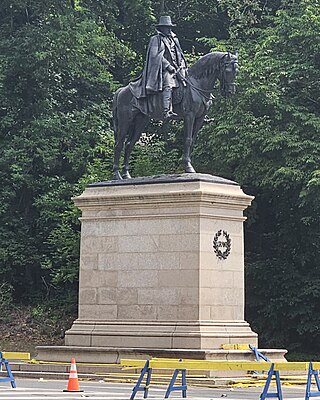
The equestrian statue of Ulysses S. Grant is a public monument in Philadelphia, Pennsylvania, United States. Located in Fairmount Park, the monument honors Ulysses S. Grant, who served as a general in the Union Army during the American Civil War and later as President of the United States. The monument was designed by Daniel Chester French and Edward Clark Potter and consists of an equestrian statue atop a pedestal. The statue was dedicated in 1899.
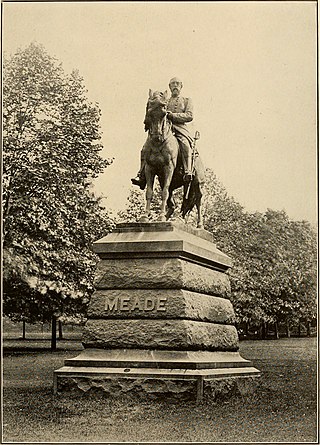
Major General George Gordon Meade is an equestrian statue that stands in Philadelphia's Fairmount Park. The statue, which was unveiled in 1887, was designed by sculptor Alexander Milne Calder and honors George Meade, who had served as an officer in the Union Army during the American Civil War and was later a commissioner for the park. The statue is one of two statues of Meade at Fairmount, with the other one being a part of the Smith Memorial Arch.
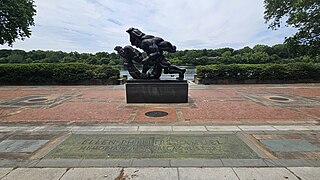
The Ellen Phillips Samuel Memorial is a sculpture garden located in Fairmount Park in Philadelphia, Pennsylvania, United States. The garden, located along the left bank of the Schuylkill River between Boathouse Row and the Girard Avenue Bridge, was established by the Fairmount Park Art Association and dedicated in 1961.



















